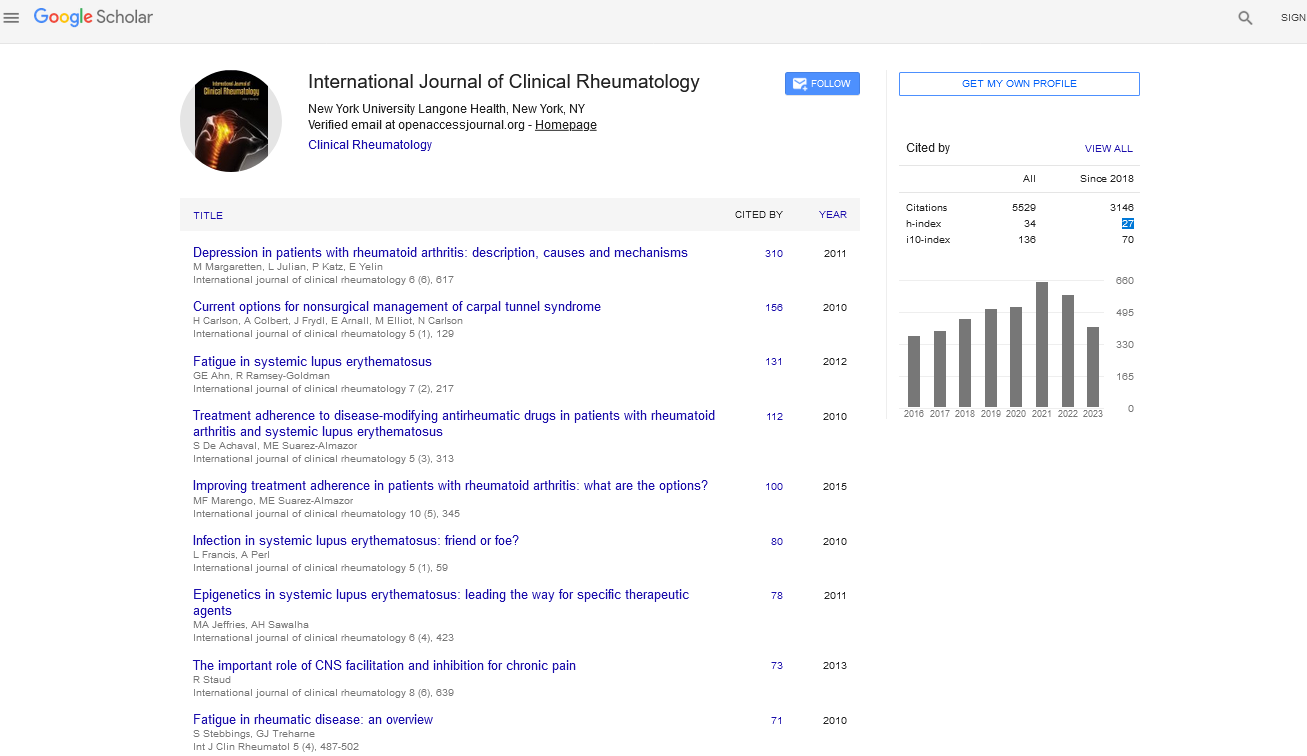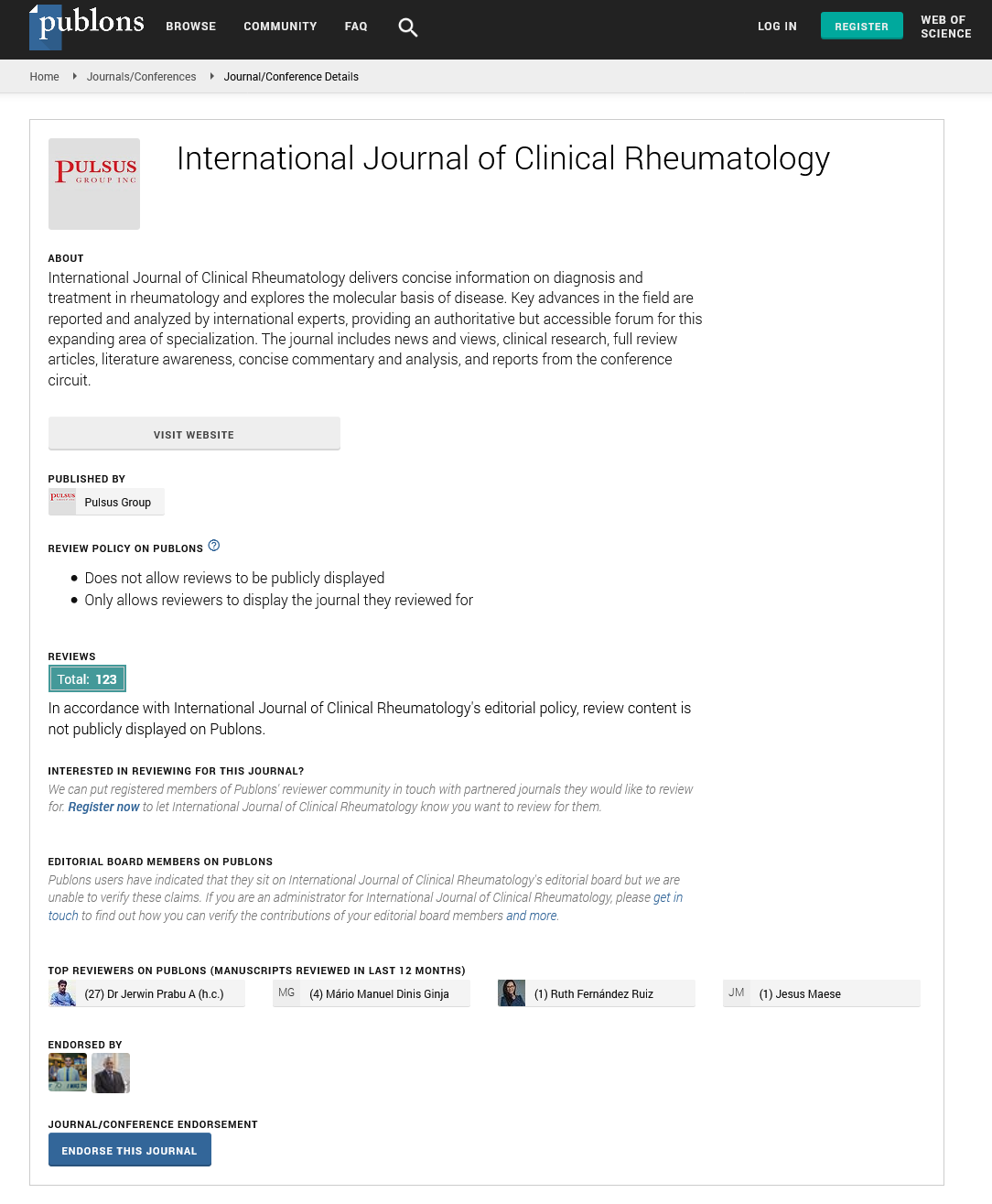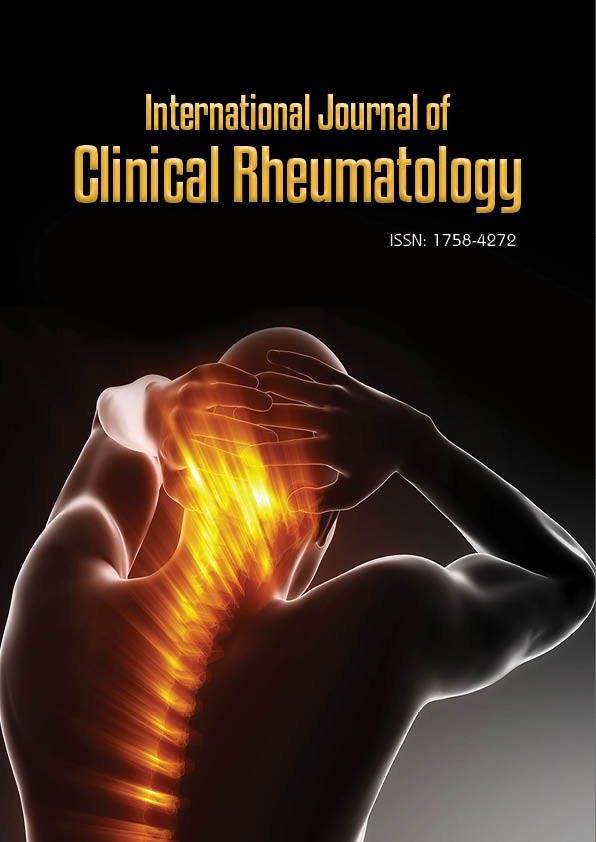Editorial - International Journal of Clinical Rheumatology (2025) Volume 20, Issue 1
Osteoarthritis: Emerging Therapies and Interventions for Disease Modification
Ethan White*
Rheumatology and Rehabilitation Department, Cairo University, Cairo, Egypt
- *Corresponding Author:
- Ethan White
Rheumatology and Rehabilitation Department, Cairo University, Cairo, Egypt
E-mail: ethan.white77@aol.com
Received: 02-Jan-2025, Manuscript No. fmijcr-25-162972; Editor assigned: 04- Jan-2025, Pre-QC No. fmijcr-25-162972 (PQ); Reviewed: 18-Jan-2025, QC No. fmijcr-25-162972; Revised: 23-Jan-2025, Manuscript No. fmijcr-25-162972 (R); Published: 30-Jan-2025, DOI: 10.37532/1758- 4272.2025.20(1).394-397
Abstract
Osteoarthritis (OA) is the most common form of arthritis, affecting millions of people worldwide, and is a leading cause of disability, particularly in older adults. Traditionally, OA management has focused on symptom relief through non-pharmacological interventions, such as exercise, weight management, and pharmacological treatments like nonsteroidal anti-inflammatory drugs (NSAIDs) and corticosteroids. However, these therapies primarily address symptoms without modifying the underlying disease process. In recent years, a growing body of research has focused on identifying treatments that can slow, stop, or even reverse disease progression. This article reviews the emerging therapies and interventions for disease modification in OA, including biologics, stem cell therapy, platelet-rich plasma (PRP) injections, and novel pharmacologic agents. Additionally, the role of non-pharmacological strategies, such as exercise and joint protection, is discussed. Although some of these therapies have shown promising results, further research is needed to determine their long-term effectiveness and safety.
Keywords
Osteoarthritis• Disease-modifying therapies• Biologics• Stem cell therapy• Platelet-rich plasma• Pharmacologic agents• Joint protection• Exercise• Novel treatments
Introduction
Osteoarthritis (OA) is a degenerative joint disease characterized by the progressive breakdown of articular cartilage, synovial inflammation, subchondral bone changes, and osteophyte formation. It most commonly affects weight-bearing joints, such as the knees, hips, and spine, and is the leading cause of disability in older adults. While OA is often considered a normal part of aging, its incidence is rising globally due to factors such as increasing life expectancy, obesity, and sedentary lifestyles. Traditionally, OA treatment has been focused on symptom management rather than altering the disease process. The primary pharmacological treatments, such as nonsteroidal anti-inflammatory drugs (NSAIDs), acetaminophen, and intra-articular corticosteroids, provide temporary relief but do not slow or reverse the underlying joint degeneration. Similarly, while joint replacement surgery is an effective solution for severe OA, it is not a viable option for all patients, particularly those with comorbidities or those in earlier stages of the disease. In recent years, there has been a growing interest in developing disease-modifying osteoarthritis drugs (DMOADs) that target the underlying mechanisms of OA. This article explores the latest advancements in OA therapy, including biologics, regenerative medicine approaches like stem cell therapy and platelet-rich plasma (PRP), and other emerging pharmacologic agents [1-4].
Emerging pharmacologic therapies
Recent research has focused on developing drugs that target the key pathological mechanisms involved in OA, such as inflammation, cartilage degradation, and subchondral bone remodeling. Although no DMOADs have been approved for routine clinical use, several promising candidates are currently under investigation.
Nerve Growth Factor (NGF) Inhibitors: NGF plays a critical role in pain and inflammation in OA. Inhibition of NGF has been shown to reduce pain and improve function in patients with knee OA. Clinical trials of monoclonal antibodies like tanezumab have demonstrated significant improvements in pain and function. However, safety concerns, including the risk of rapidly progressive OA and joint replacement, have limited the widespread adoption of NGF inhibitors.
Hyaluronic Acid (HA) Injections: HA is a naturally occurring substance in the synovial fluid that acts as a lubricant and shock absorber in joints. Intra-articular injections of HA have been used for many years to relieve pain in OA patients, though their ability to modify disease progression is still debated. Newer formulations of HA, including cross-linked versions, have demonstrated longer-lasting effects and may provide some disease-modifying benefits.
Matrix Metalloproteinase Inhibitors (MMPs): MMPs are enzymes that break down extracellular matrix components, including cartilage. Inhibition of MMPs is being explored as a strategy to prevent cartilage degradation. Several MMP inhibitors have shown promise in preclinical studies, but clinical trials have had mixed results, with some agents failing to demonstrate efficacy in humans [5-7].
Biologic therapies
Biologics are rapidly gaining attention as potential therapies for OA due to their ability to target specific inflammatory pathways involved in joint degeneration. Several biologic agents, including tumor necrosis factor (TNF) inhibitors, interleukin-1 (IL-1) inhibitors, and interleukin-6 (IL-6) inhibitors, have been evaluated in clinical trials for OA, with varying degrees of success.
TNF Inhibitors: TNF-alpha is a pro-inflammatory cytokine that plays a key role in OA-related inflammation. While TNF inhibitors have shown effectiveness in other inflammatory conditions like rheumatoid arthritis, their use in OA has not been as successful. However, ongoing studies are investigating the role of TNF inhibitors in specific OA subsets, such as those with synovitis or more severe inflammation.
IL-1 Inhibitors: IL-1 is another key inflammatory cytokine involved in cartilage breakdown. The IL-1 receptor antagonist (anakinra) has been tested in OA, with some studies suggesting a reduction in pain and improvement in joint function. However, the efficacy of IL-1 inhibitors in modifying disease progression remains inconclusive.
Stem cell therapy and platelet-rich plasma (PRP): Regenerative medicine approaches, such as stem cell therapy and PRP injections, are among the most promising strategies for disease modification in OA. Stem cells, particularly mesenchymal stem cells (MSCs), have the potential to regenerate damaged cartilage and modulate inflammation. Early clinical trials have shown that MSCs can improve pain, function, and cartilage regeneration in OA patients. PRP, which is derived from the patient’s own blood and contains high concentrations of growth factors, has also demonstrated positive results in improving joint function and reducing pain in patients with OA, particularly in the knee.
Non-Pharmacological interventions
While pharmacological therapies are crucial in managing OA, non-pharmacological interventions remain the cornerstone of treatment. These include:
Exercise and physical therapy: Regular physical activity is one of the most effective interventions for managing OA symptoms and improving joint function. Exercise has been shown to reduce pain, improve mobility, and enhance quality of life in OA patients. Strengthening exercises, low-impact aerobic activities (e.g., swimming or cycling), and flexibility exercises can help improve joint stability and reduce symptoms.
Weight management: Obesity is a significant risk factor for the development and progression of OA, particularly in the knee. Weight loss has been shown to reduce symptoms and slow disease progression by reducing the mechanical load on weight-bearing joints. Even modest weight loss can significantly improve pain and function in OA patients.
Joint protection and assistive devices: Joint protection strategies, including the use of assistive devices (e.g., knee braces, walking aids), can help reduce joint stress and improve function. Education on joint protection techniques is an important part of OA management.
Discussion
While the traditional treatment approach for OA has focused primarily on symptom relief, recent advancements have brought us closer to the possibility of disease modification. Biologic therapies and regenerative treatments, such as stem cell therapy and PRP, show great potential for slowing disease progression and even promoting cartilage regeneration. However, challenges remain, particularly in terms of long-term safety and efficacy, as well as the high cost and availability of these therapies. The development of DMOADs, particularly those targeting specific inflammatory pathways like NGF and IL-1, offers hope for disease-modifying therapies in OA. However, clinical trials to date have yielded mixed results, and more research is needed to identify patients who would benefit the most from these treatments. Non-pharmacological interventions, including exercise, weight management, and joint protection, remain foundational in the management of OA. These approaches are cost-effective and have been shown to improve both symptoms and quality of life. As such, they should continue to be integral components of any comprehensive OA treatment plan [8-10].
Conclusion
Osteoarthritis remains a major health challenge, particularly with the aging population. While current treatments mainly focus on symptom management, emerging therapies offer hope for disease modification and potentially slowing or halting joint degeneration. Biologics, stem cell therapy, PRP injections, and novel pharmacologic agents all show promise in altering the course of the disease. However, further research and long-term clinical trials are essential to confirm their efficacy and safety. Non-pharmacological strategies, such as exercise and weight management, should continue to be an integral part of OA management. The future of OA treatment lies in a personalized approach that combines pharmacological, regenerative, and lifestyle interventions to optimize patient outcomes.
References
- Abolfazl Akbarzadeh. Liposome: Classification, Preparation, and Applications. Nanoscale Res Lett. 8, 102 (2013).
- Goyal M.Endovascular thrombectomy after large vessel ischaemic stroke: a meta- analysis of individual patient data from five randomised trials. Lancet. 22, 416-430 (2016).
- Hamdi Nsairat. Liposomes: Structure, Composition, Types, and Clinical Applications. Heliyon. 8, 9394 (2022).
- Abolfazl Akbarzadeh. Liposome: Classification, Preparation, and Applications. Nanoscale Res Lett. 8, 102 (2013).
- Goyal M.Endovascular thrombectomy after large vessel ischaemic stroke: a meta- analysis of individual patient data from five randomised trials. Lancet. 22, 416-430 (2016).
- Thorn, Caroline F. Doxorubicin Pathways: Pharmacodynamics and Adverse Effects. Pharmacogenet Genomics. 21, 440-446 (2011).
- Brunelli D, Polonelli T, Benini L. Ultra-low energy pest detection for smart agriculture. IEEE Sens J. 1-4 (2020).
- Crippen TL, Poole TL. Conjugative transfer of plasmid-located antibiotic resistance genes within the gastrointestinal tract of lesser mealworm larvae,Alphitobius diaperinius(Coleoptera: Tenebrionidae). Foodborne Pathog Dis. 7, 907-915 (2009).
- Dwyer, Claire. ‘Highway to Heaven’: the creation of a multicultural, religious landscape in suburban Richmond, British Columbia. Soc Cult Geogr. 17, 667-693 (2016).
- Taniguchi S, Ryu J, Seki M. Long-term oral administration of glucosamine or chondroitin sulfate reduces destruction of cartilage and up-regulation of MMP-3 mRNA in a model of spontaneous osteoarthritis in Hartley guinea pigs. J Orthop Res. 30(5), 673-678 (2012).
Indexed at, Google Scholar, Crossref
Indexed at, Google Scholar, Crossref
Indexed at, Google Scholar, Crossref
Indexed at, Google Scholar, Crossref
Indexed at, Google Scholar, Crossref
Indexed at, Google Scholar, Crossref
Indexed at, Google Scholar, Crossref
Indexed at, Google Scholar, Crossref


